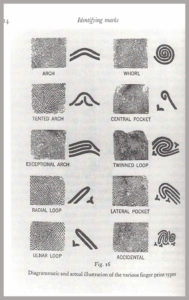The use of the fingerprint as a unique identifier can be traced to ancient Babylon, but it wasn’t till the 19th century that serious scientific attention turned to the study of “skin-furrows”, when anatomists Purkyne (1823) and Von Meissner (1853) published papers on finger patterns and ridges. In the 1850s, Wiliam Hershel began to experiment with fingerprints as a means to identify villagers in India and in 1880 Henry Faulds published his first paper proposing a method to record an individual’s fingerprints with printing ink. Arthur Conan Doyle was interested in this emerging forensic science, so when Sherlock Holmes made his first appearance in 1887, he claimed to be able to recognize his criminal, among other traits, by “the callosities of his forefinger and thumb”. Sir Francis Galton’s landmark forensics book, Finger Prints, arrived five years later, and in 1894 the London police began collecting the fingerprints of suspected criminals.

Anglo-American detective fiction continued to popularize the notions of forensic science, and by the time of The Adventure of the Norwood Builder (1903), the credibility of the techniques was so firmly established in the Holmes canon (if not yet in police practice) that the culprit would try in vain to use fraudulent fingerprint evidence to frame an innocent man. R. Austin Freeman’s first Dr. Thorndyke mystery, The Red Thumb Mark (1907), was also based on a scientific detective’s discovery of a forged fingerprint. The UK’s actual first conviction based on fingerprint evidence was less dramatic: labourer Harry Jackson was found guilty of stealing billiard balls – yes, you read that right – from a house in South London in 1902. A clear left thumbprint on a recently-painted window sill was matched with Jackson’s and he was sentenced to seven years imprisonment. Those were hard times.
A recent discovery shows how long it can take for a new idea to get traction. On the night of May 5th 1840, Lord William Russell was murdered in his Mayfair townhouse. The discovery of the 73 yr-old politician in bed with his throat cut was a huge scandal, and sparked a major investigation by the 10 year-old Metropolitan Police. Having read the lurid newspaper reports of bloody hand-prints on bed sheets, Norfolk surgeon Robert Blake Overton wrote a three-page letter of advice to Lord John Russell, the victim’s nephew and a future prime minister: “It is not generally know that every individual has a peculiar arrangement [on] the grain of the skin…I would recommend the propriety of obtaining impressions from the fingers of the suspected individual and a comparison made with the marks on the sheets and pillows.” Overton even included example of inky fingerprints to demonstrate his concept. His letter was passed to Scotland Yard, who did look into the matter (“there were no such marks” was recorded on the back of the letter) but failed to grasp the wider implications of the idea. The letter was filed away until 2012, when the collection of original documents relating to the murder was sold at Sothebys. Overton disappeared from the history of forensics.
And in this case, the butler did it. Russell discovered his valet Francois Benjamin Courvoisier had stolen valuables and told him he would be dismissed the next morning. Courvoisier panicked and killed him.
Header image from Colliers Magazine, Vol 32(5), Oct 31 1903. Illustration by Frederic Dorr Steele.